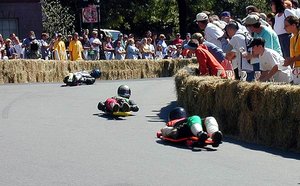Street luge
|
|
Street luge is an extreme gravity-powered activity that involves riding a street luge board (sometimes referred to as a sled) down a paved road or course. Street luge is also known as land luge or road luge. Like skateboarding, street luge is often done for recreation and for sport.
Other than the prone riding position and greater than 70 mile per hour (100 km/h) speed, street luge has little relation to its winter namesake (luge).
| Contents |
History
Street luge was born in Southern California as downhill skateboarders found they could reach faster speeds by lying down on their skateboards. This early form of the sport is now referred to as "classic style" or "butt boarding".
In 1975 the first professional race was held at Signal Hill, California and hosted by the U.S. Skateboard Association. The race winner was based on top speed. The boards used in this race varied from basic skateboards to complex skate cars in which the rider was completely enclosed by plastic or fiberglass. The sport was not commonly referred to street luge at this time but the term luge was used to describe some participants riding position. Most contestants were standing up however an opening in the rules enabled riders to choose their on board position - including prone. By 1978, repeated injuries to both riders and spectators halted the races at Signal Hill.
Several riders from the Signal Hill races kept the sport alive by continuing to hold races in Southern California. Throughout the 1980s and into the early 1990s, both underground and professional races continued to be held in Southern California by such organizations as the Underground Racers Association (URA), Federation of International Gravity Racing (FIGR) and Road Racers Association for International Luge (RAIL). Race organizers in the 1980s and 1990s started implementing many more equipment, safety and race regulations.
Meanwhile in the early 1990s some Austrian skateboarders started sitting down on their skateboards on the way back from teaching skiing in the Alps. This activity lead to a penultimate classic style street luge race in Austria. There is now a healthy street luge riding and racing presence in many European countries (see below).
In the mid 1990s, ESPNís X Games showcased street luge to the world and the sport was originally sanctioned by RAIL, then by the International Gravity Sports Association (IGSA). NBC followed ESPNís lead and created the Gravity Games in which the sport was sanctioned by Extreme Downhill International (EDI). Qualification criteria for these events varied and was controlled by each of the sanctioning bodies.
While no longer a sport in either the X Games or Gravity Games, street luge is a burgeoning sport in numerous countries with competitions in the U.S., Canada, South Africa, Australia, Switzerland, Germany, Sweden and the U.K. There are approximately 1,200+ active street luge riders in the world.
Equipment, Safety & Racing
Street lugers ride modified skateboards in the prone position. The design of these boards is based on the rules set forth from different governing bodies. Consistent design elements include:
- The use of lean activated steering skateboard style trucks
- The prohibited use of mechanical brakes
- Front and rear padding
- Length, width and weight restrictions - details depend on sanctioning body
- The prohibited use of parts that enclose the riderís body or hinder braking
Current street luge boards are made from many materials including steel, aluminum, wood, and carbon fiber. The majority of the street luge boards in the world are custom made although commercial models are now available. Actual board designs can vary as the construction rules are very open and allow for numerous design considerations.
Riders participating in sanctioned racing events are required to wear safety equipment including:
- Hard shell helmet with chin strap and face shield or goggles
- Leather or Kevlar racing suit
- Leather or Kevlar gloves
Race courses are usually held on mountain roads but have been held on city streets as well. Courses can range in length from 0.5 to 3 miles (1 to 5 km) and vary in layout (number and severity of turns). Racing can take the following formats:
- Single elimination with 2, 4, or 6 racers at a time
- Double elimination with 2, 4, or 6 racers at a time
- Timed trials
- No elimination points system (points for each finishing position in several heats)
- Mass runs, with up to 20 racers at a time (positions are decided by the order they cross the finish line)
Governing Bodies
Street luge is currently governed by numerous organizations around the world. Each of these organizations has it own rules although all of them are similar.
- IGSA (http://gravity-sports.com/index.html) (International Gravity Sports Association) is based in Southern California and sanctions events all around the world. The IGSA was the ruling body for street luge during the 1997-2001 X Games - Rules (PDF) (http://gravity-sports.com/rulebooks/2004/2004_igsa_rulebook_final.pdf)
- GSI (http://www.gravitysportsinternational.com/) (Gravity Sports International) is based in Loudon New Hampshire and sanctions races along the east cost of the U.S. They feature several novel racing classes such as Rookie, Amateur and Junior. Rules (http://www.gravitysportsinternational.com/rules.html)
External Links
- StreetLuge.com (http://www.streetluge.com)
- Popular Street Luge Message Forum (http://www.streetluge.net/webbbs)
- Gravity DB Online Gravity Sports Database (http://www.gravitydb.com/)
- Street Luge Events and Pictures (http://www.auldovertheroad.com)
Books & Videos
- Lott, Darren (1961-). Street Luge Survival Guide (1st ed.). Gravity Publishing. 1998 ISBN 0-9662563-7-9
- Nichols, John (1966-). Street Luge. Raintree Steck-Vaughn. 2002 ISBN 0-739-4692-2
- Kahn, Jeremy (1981-). Street Luge 101. Kahn Productions. 2004 -http://www.streetluge101.comfr:Streetluge

